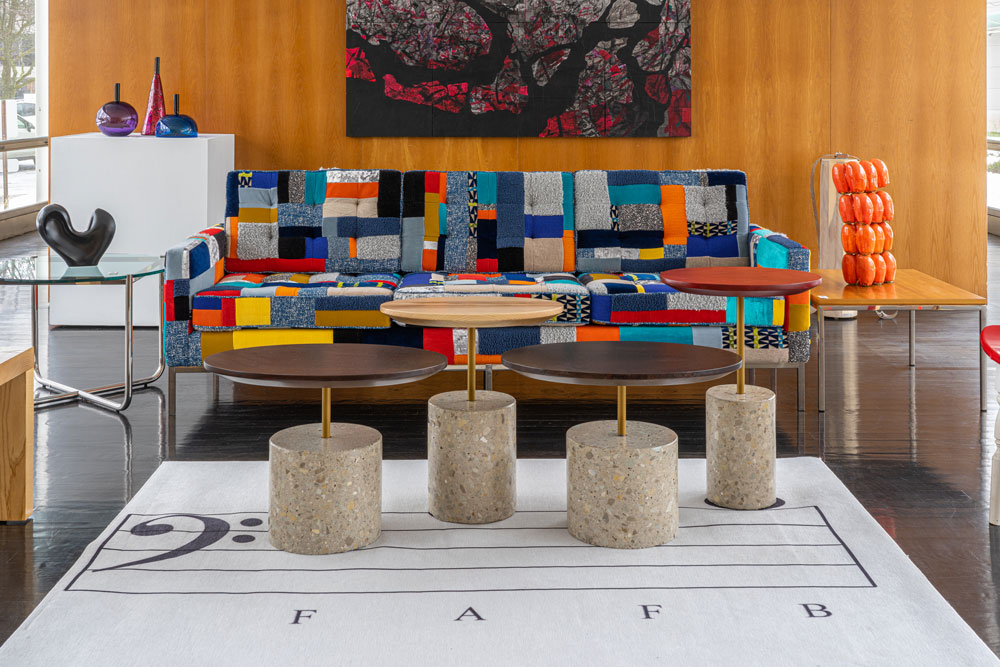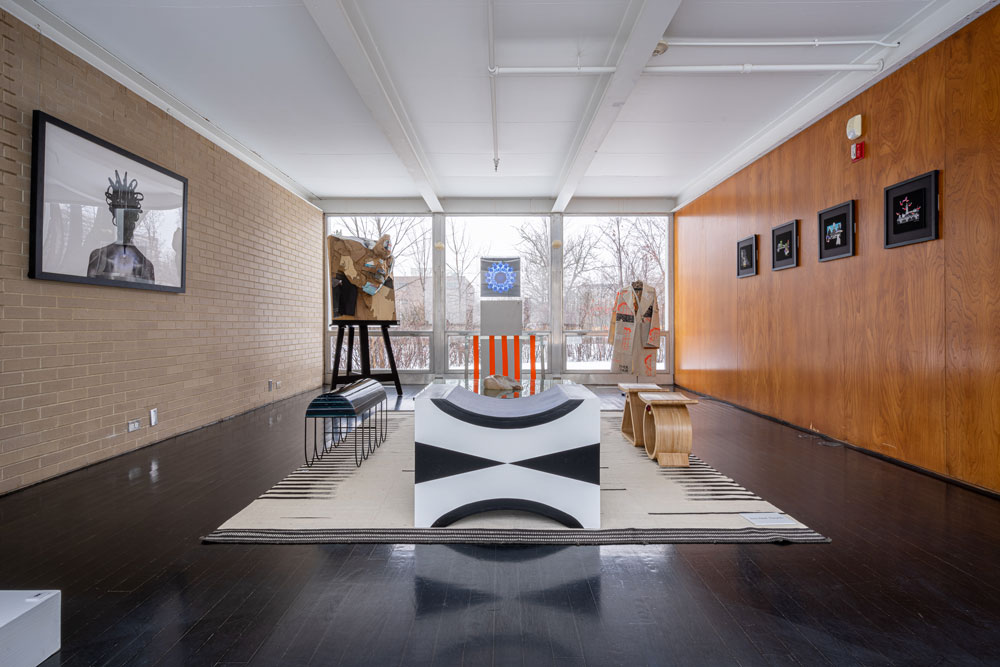
A newly opened two-part exhibit at the Elmhurst Art Museum looks into how profoundly one art form can impact and influence another. A Love Supreme: Norman Teague, chronicles how John Coltrane’s 1964 jazz masterpiece has and continues to inspire pioneering Chicago designer and educator, Norman Teague. A Love Supreme: McCormick House Reimagined expands the dialogue of how music and like muses nourish the imagination of 35 other BIPOC artists. Gathered together in the modernist calm of the museum’s McCormick House, their work powerfully affirms the vibrant creativity thriving in the BIPOC community.
Coltrane divided his jazz triumph into four parts, Acknowledgement, Resolution, Pursuance and Psalm. A Love Supreme: Norman Teague emulates that structure with four galleries in the museum’s main building carrying the same themes. In them, Teague has attempted to create his own visual concept album inspired by Coltrane’s music. Best known for his custom furniture and sculpture, wood often is at the center of his renderings that blur the line between art and contemporary design. It’s that new artistic world he creates through his pieces that make them so curious, arresting and conceptually appealing.

Long a person who instinctively enjoys working with his hands, Teague uncovered the ideal outlet for releasing that passion in Columbia College’s wood shop. The discovery proved a turning point in his creative life. The range of expression he achieves through the medium is striking. Several of the pieces in his exhibition are presented beautifully sanded and raw with no varnish or sheen. The effect is to turn the wood’s grain into a key aspect of the work’s beauty. A member of the design team of the Obama Presidential Center, Teague also feels driven to have his art reflect sensibilities specific to the African American community. Aspects of that desire can be seen in his contemporary riffs on objects endemic to the African continent. Full scaled, airy and welcoming, Roundhouse seems to have touchstones from around the globe. Made up of poplar, maple, plywood and fishing line, it resembles the elegant skeleton of some distant or ancient native dwelling. Despite the way it recalls antiquity, it also looks light, fresh and contemporary. On the wall next to it is Coat Rack. Six highly stylized wood pieces that call to mind handsome boomerangs, most with a least one colorful knob that could be used to hang a garment. It’s an ingenious incorporation of function and whimsy. The ZizZag bookshelf in the Psalm gallery accomplishes the same end, making the practical wonderfully peculiar and distinctive. Scattered throughout the latter two galleries, design that echoes both cubism and the improvisational structure of jazz are mounted on walls or sit as fantastical furniture from some alternate jazz defined universe.

The atmosphere changes in McCormick House where the contributions of other BIPOC artists reign. With its intimacy and light, the Mies van der Rohe gem has proven an ideal environment to display a wide spectrum of art. Asked “What is your Coltrane story?”, the tangible results of that question adorn the house as objects of furniture, sculpture, photography, decorative glass, ceramic stoneware and much more. Exhibition notes also reveal each of the 35 artists’ direct responses to the question. Many confide thoughts on how they approach their work generally. And often, they go one to talk about the catalyst behind the work they contributed to the exhibition. They all note a particular song that’s proven to be a reliable creative resource for them personally. QR codes in the exhibition allow visitors to tap directly into those musical references.

Spiritual and transcendent are two words commonly heard when talking about A Love Supreme. The music is certainly penetrating and radiates timeless wonder. Roger Carter, who created A Trane, a spectacular close-up portrait of Mr. Coltrane from broken records, believes “music plays a major role in art.” By adding “Coltrane’s music got me through college”, he reveals how the album’s resonance has the power to encourage and sustain. There’s also a haunting element infused into its music that comes through in Kinda Blue, a serenely moving photograph of Coltrane in deep shadow by Tony Smith.

Lush with books, furnishings and art that mirror a deeply realized cultural aesthetic, the Listening Lounge is intended to be a place to rest and absorb the character of the space. Arranged to feel like a comfortable room or den in a family home, every object stands in harmony with everything around it to telegraph a message advocating self-realization and fulfillment.
Those artists included in the exhibition hailing from Spain, Nigeria, Puerto Rico and other parts of the globe also note the importance music, or Coltrane specifically; has, and is making to their artistic process. Just as notably, they include emotional vestiges and memories of their home countries in their creations; giving them well appreciated dimension and perspective.
In combination, the two exhibits highlight an interconnectivity between the arts that’s not often recognized. A Love Supreme: Norman Teague and A Love Supreme: McCormick House Reimagined celebrates the link that joins them by showcasing the wealth of beauty that results from their union.
A Love Supreme: Norman Teague
A Love Supreme: McCormick House Reimagined
Through April 28th, 2024
Elmhurst Art Museum
150 Cottage Hill Avenue
Elmhurst, IL 60126
Headphones and smartphones are recommended